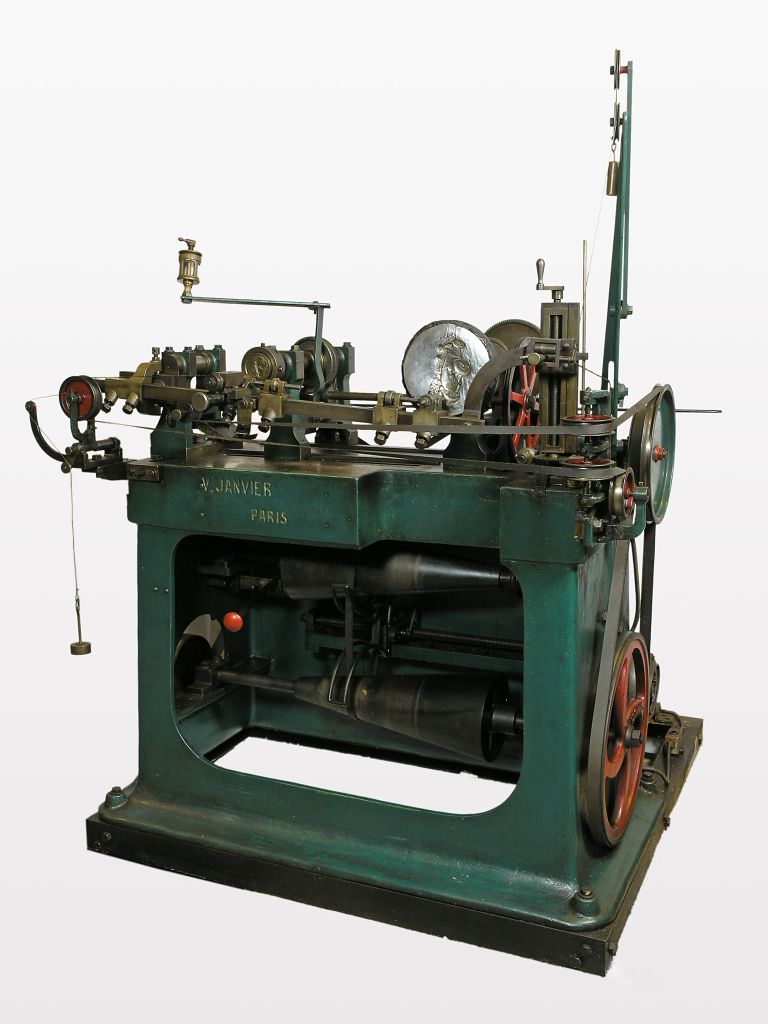Reducing Machine on:
[Wikipedia]
[Google]
[Amazon]
 A Reducing Machine was a type of
A Reducing Machine was a type of
EXTERNAL LINK Royal Mint Reducing Engine webpage https://www.royalmintmuseum.org.uk/journal/curators-corner/janvier-reducing-machine/
 A Reducing Machine was a type of
A Reducing Machine was a type of pantograph
A pantograph (, from their original use for copying writing) is a mechanical linkage connected in a manner based on parallelograms so that the movement of one pen, in tracing an image, produces identical movements in a second pen. If a line dr ...
lathe
A lathe () is a machine tool that rotates a workpiece about an axis of rotation to perform various operations such as cutting, sanding, knurling, drilling, deformation, facing, and turning, with tools that are applied to the workpiece ...
used until the 21st century to manufacture coin dies Dies may refer to:
* Dies (deity), the Roman counterpart of the Greek goddess Hemera, the personification of day, daughter of Nox (Night) and Erebus (Darkness).
* Albert Christoph Dies (1755–1822), German painter, composer, and biographer
* Jos ...
. Prior to the machine's introduction, designs were cut by hand into metal dies by a specialist engraver. The reducing machine changed this by allowing artists to create designs on a larger surface area and then have them scaled down and cut into a die automatically. The most successful version of the machine, created by Victor Janvier
Victor Janvier (1851–1911) was a French sculptor and engraver notable for inventing the Janvier Reducing Machine, a type of lathe which improved the die making process within mints
A mint or breath mint is a food item often consumed as an ...
, was used by mints all around the world including the US Mint who operated one as late as 2008 when it was replaced by CNC milling machines.
History
Contamin Pantograph
From 1836 to 1867 the US Mint operated the first die-engraving pantograph invented by a now forgotten French inventor whom the machine is named after. It used a rotating cutter to copy a design.Hill Pantograph
During the mid 1800s Englishman C. J. Hill developed a variation of the Contamin whereby the electrotype was traced horizontally using atreadle
A treadle (from oe, tredan, "to tread") is a mechanism operated with a pedal for converting reciprocating motion into rotating motion. Along with cranks, treadmills, and treadwheels, treadles allow human and animal machine power in the a ...
. Hill sold his idea to William Wyon
William Wyon (Birmingham 1795 – 29 October 1851), was official chief engraver at the Royal Mint from 1828 until his death.
Biography
Wyon was born in Birmingham and, in 1809, was apprenticed to his father, Peter Wyon who was an engraver a ...
, the then chief engraver at the Royal Mint
The Royal Mint is the United Kingdom's oldest company and the official maker of British coins.
Operating under the legal name The Royal Mint Limited, it is a limited company that is wholly owned by HM Treasury, His Majesty's Treasury and is un ...
who sold a machine to the US Mint in September 1867.
Janvier Reducing Machine
In 1899, French engraverVictor Janvier
Victor Janvier (1851–1911) was a French sculptor and engraver notable for inventing the Janvier Reducing Machine, a type of lathe which improved the die making process within mints
A mint or breath mint is a food item often consumed as an ...
patented a design which solved the inefficiency problem. By using twin cone belt drives that pointed in opposite directions dies could be cut much faster by increasing the speed as the cutting point moved outwards. After several days a reduction punch is produced, which is then used to produce working dies. Machines using Janvier's improved design were bought by the British Royal Mint
The Royal Mint is the United Kingdom's oldest company and the official maker of British coins.
Operating under the legal name The Royal Mint Limited, it is a limited company that is wholly owned by HM Treasury, His Majesty's Treasury and is un ...
in 1901 and by the US Mint in 1907.EXTERNAL LINK Royal Mint Reducing Engine webpage https://www.royalmintmuseum.org.uk/journal/curators-corner/janvier-reducing-machine/
References
{{reflist, 30em Lathes Metalworking tools French inventions